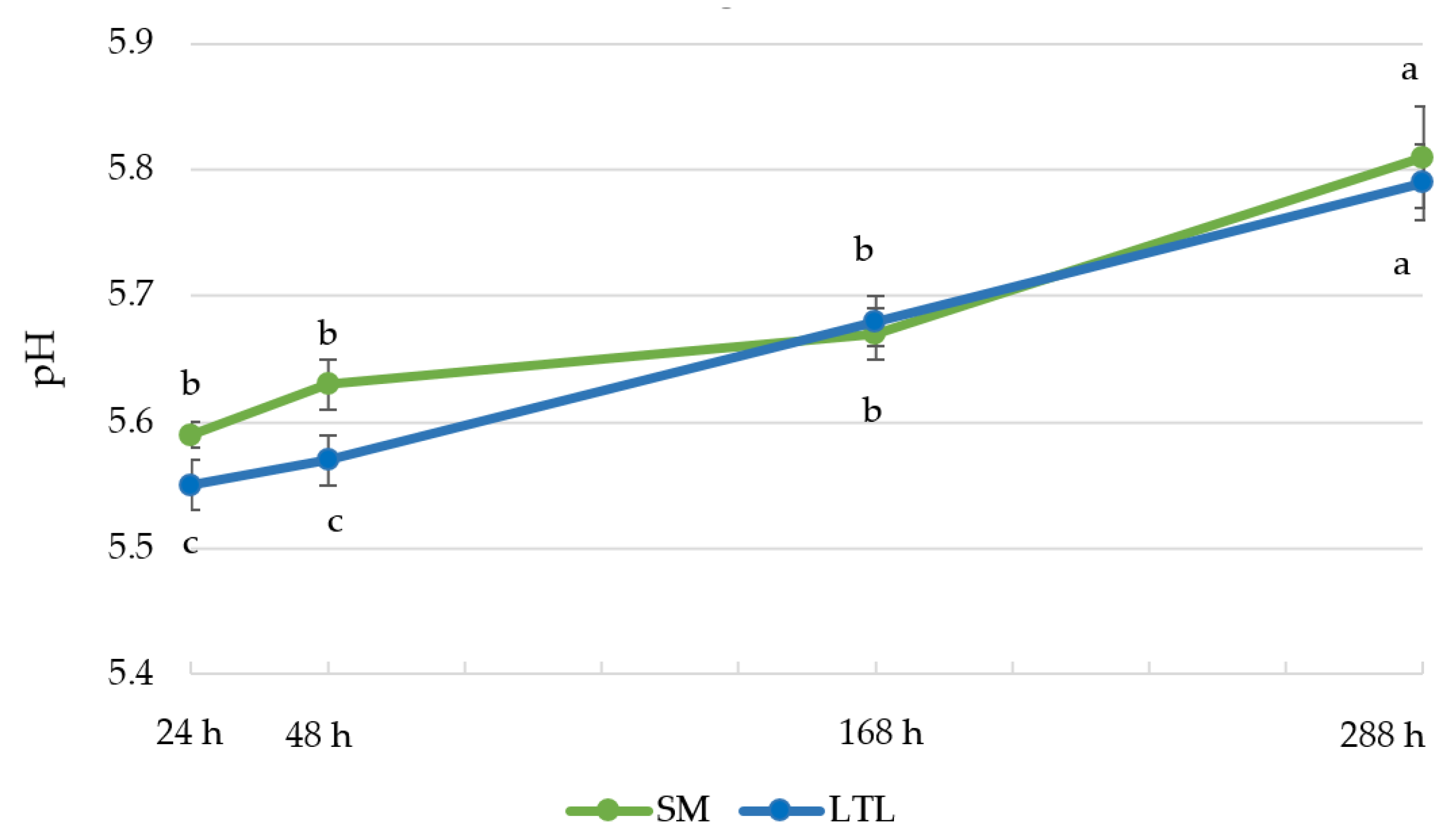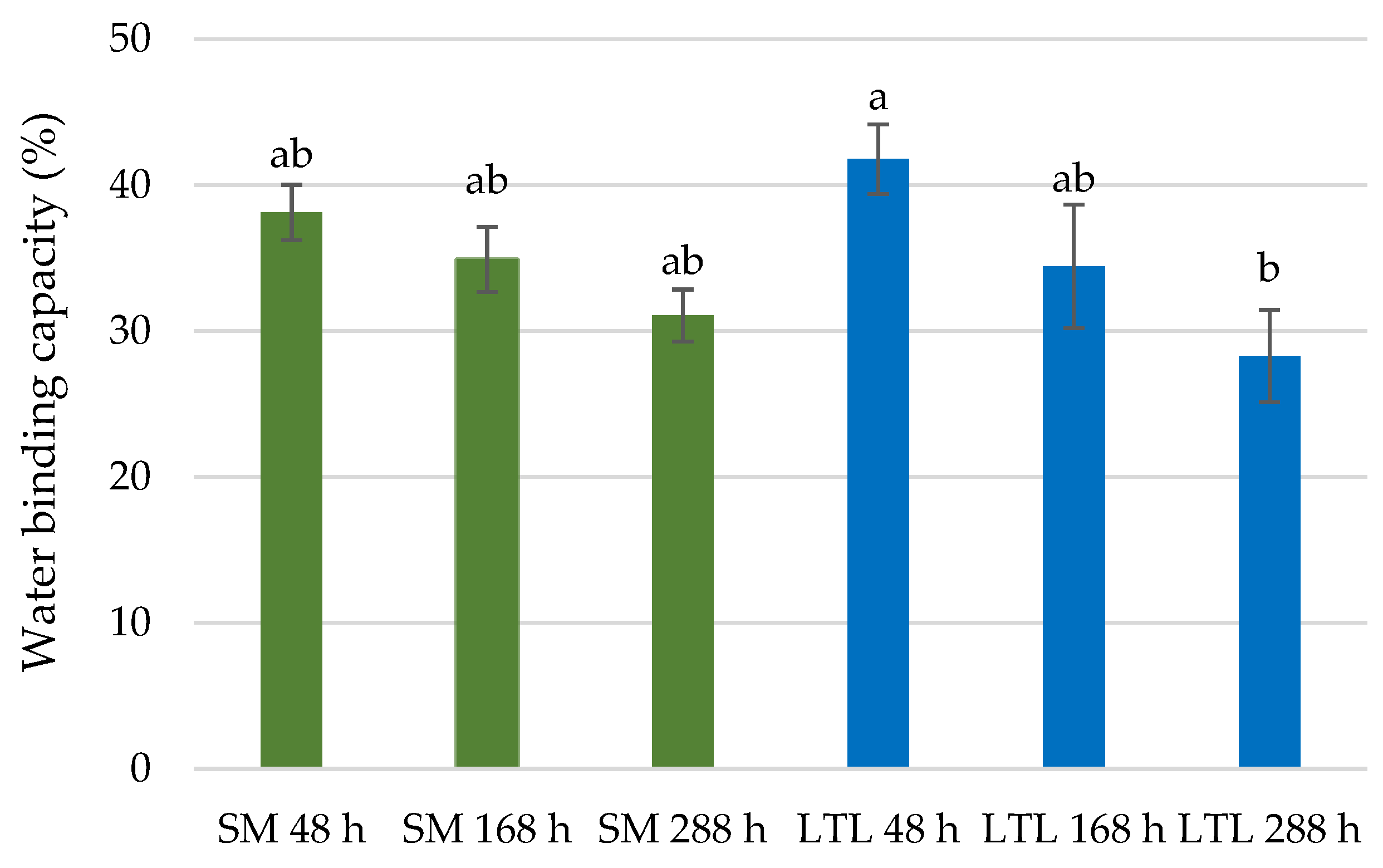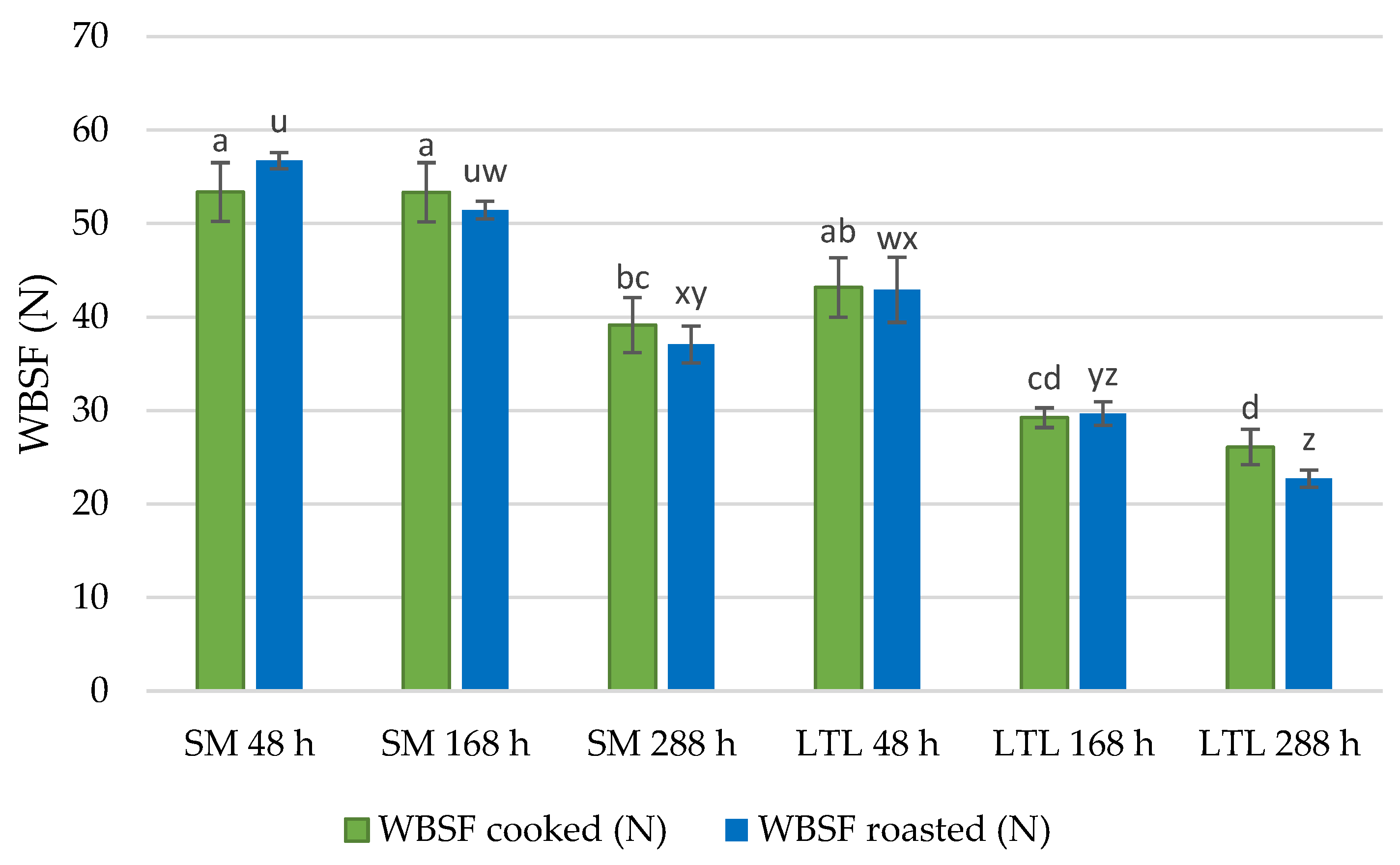Changes in Water Holding Capacity and Shear Force in Fallow Deer Muscles during Ageing
Abstract
1. Introduction
2. Materials and Methods
2.1. Material
2.2. Physico-Chemical Methods
2.3. Statistical Analysis
3. Results
3.1. Changes in pH during Ageing
3.2. The Ability to Retain Own and Added Water
3.3. Thermal-Treated Fallow Deer Meat
3.4. Similarities between LTL and SM Muscles Aged for Different Times
3.5. Correlations
4. Discussion
5. Conclusions
Author Contributions
Funding
Institutional Review Board Statement
Informed Consent Statement
Data Availability Statement
Conflicts of Interest
References
- Kudrnáčová, E.; Bartoň, L.; Bureš, D.; Hoffman, L.C. Carcass and meat characteristics from farm-raised and wild fallow deer (Dama dama) and red deer (Cervus elaphus): A review. Meat Sci. 2018, 141, 9–27. [Google Scholar] [CrossRef] [PubMed]
- Milczarek, A.; Janocha, A.; Niedziałek, G.; Zowczak-Romanowicz, M.; Horoszewicz, E.; Piotrowski, S. Health-promoting properties of the wild-harvested meat of roe deer (Capreolus capreolus L.) and red deer (Cervus elaphus L.). Animals 2021, 11, 2108. [Google Scholar] [CrossRef]
- Kasprzyk, A.; Kilar, J.; Walenia, A.; Kusz, B. Comparison of lipid properties and cadmium and lead content in red deer (Cervus elaphus) meat from three feeding grounds. Animals 2022, 12, 2859. [Google Scholar] [CrossRef] [PubMed]
- Polish Law Gazette 2001 No. 129 Position 1438. Act of 25 July 2001 Amending the Act on the Profession of Veterinary Surgeon and Chambers of Veterinary Medicine, the Act on Combating Infectious Diseases of Animals, Examination of Slaughter Animals and Meat, and Veterinary Inspection and the Act on Organization of Breeding and Reproduction of Farm Animals. Available online: http://prawo.sejm.gov.pl/isap.nsf/DocDetails.xsp?id=WDU20011291438 (accessed on 17 April 2019).
- Główny Inspektorat Weterynarii, 2022. Weterynaryjna Sprawozdawczość Statystyczna (RRW). Available online: https://www.wetgiw.gov.pl/publikacje/rrw-sprawozdawczosc-statystyczna (accessed on 27 January 2023).
- Tajchman, K.; Ukalska-Jaruga, A.; Ceacero, F.; Pecio, M.; Steiner-Bogdaszewska, Z. Concentration of macroelements and trace elements in farmed fallow deer antlers depending on age. Animals 2022, 12, 3409. [Google Scholar] [CrossRef] [PubMed]
- Bijl, H.; Csányi, S. Fallow deer (Dama dama) population and harvest changes in Europe since the early 1980s. Sustainability 2022, 14, 12198. [Google Scholar] [CrossRef]
- Korkmaz, B.; Maaz, D.; Reich, F.; Gremse, C.; Haase, A.; Mateus-Vargas, R.H.; Mader, A.; Rottenberger, I.; Schafft, H.A.; Bandick, N.; et al. Cause and effect analysis between influencing factors related to environmental conditions, hunting and handling practices and the initial microbial load of game carcasses. Foods 2022, 11, 3726. [Google Scholar] [CrossRef] [PubMed]
- Kilar, J.; Kasprzyk, A. Fatty acids and nutraceutical properties of lipids in fallow deer (Dama dama) meat produced in organic and conventional farming systems. Foods 2021, 10, 2290. [Google Scholar] [CrossRef]
- Czurgiel, S.; Antoszkiewicz, Z.; Mazur-Kuśnirek, M.; Bogdaszewski, M. The effect of the inclusion of different concentrates in feed rations on the contents of tocopherols, β-carotene and retinol in the livers and longissimus dorsi muscles of farm-raised fallow deer (Dama dama L.). Animals 2022, 12, 3311. [Google Scholar] [CrossRef]
- Żmijewski, T.; Modzelewska-Kapituła, M.; Pomianowski, J.; Ziomek, A. Farmed-raised fallow deer (Dama dama L.) carcass characteristics and meat nutritional value. J. Food Sci. Technol. 2020, 57, 3211–3220. [Google Scholar] [CrossRef]
- Hamm, R. Functional properties of the myofibrillar system and their measurements. In Muscle as Food; Bechtel, P.J., Ed.; Academic Press, Inc.: New York, NY, USA, 1986; pp. 135–199. [Google Scholar]
- Barbera, S. WHCtrend, an up-to-date method to measure water holding capacity in meat. Meat Sci. 2019, 152, 134–140. [Google Scholar] [CrossRef]
- Karwowska, M.; Kononiuk, A.D.; Borrajo, P.; Lorenzo, J.M. Comparative studies on the fatty acid profile and volatile compounds of fallow deer and beef fermented sausages without nitrite produced with the addition of acid whey. Appl. Sci. 2021, 11, 1320. [Google Scholar] [CrossRef]
- Żochowska-Kujawska, J.; Kotowicz, M.; Sobczak, M.; Lisiecki, S. Effect of muscle fibre type on the fatty acids profile and lipid oxidation of dry-cured venison SM (semimembranosus) muscle. Foods 2022, 11, 2052. [Google Scholar] [CrossRef] [PubMed]
- Wierbicki, E.; Tiede, M.G.; Burrell, R.C. Determination of meat swelling as a method for investigating the water-binding capacity of proteins with low water holding forces. Fleischwirtschaft 1962, 14, 951–958. [Google Scholar]
- Kauffman, R.G.; Eikelenboom, G.; Van der Wal, P.G.; Engel, B.; Zaar, M. Comparision of methods to estimate water-holding capacity in post-rigor porcine muscle. Meat Sci. 1986, 18, 307–322. [Google Scholar] [CrossRef] [PubMed]
- Honikel, K.O. Reference methods for the assessment of physical characteristics of meat. Meat Sci. 1998, 49, 447–457. [Google Scholar] [CrossRef]
- Bykowska, M.; Stanisz, M.; Ludwiczak, A.; Skladanowska, J.; Ślósarz, P. Quality of meat from three muscles of farmed fallow deer (Dama dama). Anim. Prod. Sci. 2018, 58, 376–384. [Google Scholar] [CrossRef]
- Cifuni, G.F.; Amici, A.; Contò, M.; Viola, P.; Failla, S. Effects of the hunting method on meat quality from fallow deer and wild boar and preliminary studies for predicting lipid oxidation using visible reflectance spectra. Eur. J. Wildl. Res. 2014, 60, 519–526. [Google Scholar] [CrossRef]
- Pollard, J.C.; Littlejohn, R.P.; Asher, G.W.; Pearse, A.J.T.; Stevenson-Barry, J.M.; McGregor, S.K.; Manley, T.R.; Duncan, S.J.; Sutton, C.M.; Pollock, K.L.; et al. A comparison of biochemical and meat quality variables in red deer (Cervus elaphus) following either slaughter at pasture or killing at a deer slaughter plant. Meat Sci. 2002, 60, 85–94. [Google Scholar] [CrossRef]
- Ludwiczak, A.; Bykowska-Maciejewska, M.; Składanowska-Baryza, J.; Stanisz, M. Influence of the method of storage on the quality of venison from wild fallow deer (Dama dama). Meat Sci. 2019, 156, 98–104. [Google Scholar] [CrossRef] [PubMed]
- Warner, R.D. Chapter 14—The Eating Quality of Meat—IV Water-Holding Capacity and Juiciness. In Lawrie’s Meat Science, 8th ed.; Toldrá, F., Ed.; Woodhead Publishing: Sawston, UK, 2017; pp. 419–459. [Google Scholar] [CrossRef]
- Hughes, J.M.; Oiseth, S.K.; Purslow, P.P.; Warner, R.D. A structural approach to understanding the interactions between colour, water-holding capacity and tenderness. Meat Sci. 2014, 98, 520–532. [Google Scholar] [CrossRef]
- Modzelewska-Kapituła, M.; Kwiatkowska, A.; Jankowska, B.; Dąbrowska, E. Water holding capacity and collagen profile of bovine m. infraspinatus during postmortem ageing. Meat Sci. 2015, 100, 209–216. [Google Scholar] [CrossRef] [PubMed]
- Huff-Lonergan, E.J.; Lonergan, S.M. Mechanisms of water-holding capacity of meat: The role of postmortem biochemical and structural changes. Meat Sci. 2005, 71, 194–204. [Google Scholar] [CrossRef]
- Dominguez-Hernandez, E.; Salaseviciene, A.; Ertbjerg, P. Low-temperature long-time cooking of meat: Eating quality and underlying mechanisms. Meat Sci. 2018, 143, 104–113. [Google Scholar] [CrossRef] [PubMed]
- Baldwin, D.E. Sous vide cooking: A review. Int. J. Gastron. Food Sci. 2012, 1, 15–30. [Google Scholar] [CrossRef]
- Koohmaraie, M.; Geesink, G.H. Contribution of postmortem muscle biochemistry to the delivery of consistent meat quality with particular focus on the calpain system. Meat Sci. 2006, 74, 34–43. [Google Scholar] [CrossRef] [PubMed]
- Marino, R.; Albenzio, M.; della Malva, A.; Santillo, A.; Loizzo, P.; Sevi, A. Proteolytic pattern of myofibrillar protein and meat tenderness as affected by breed and aging time. Meat Sci. 2013, 95, 281–287. [Google Scholar] [CrossRef]
- Tkacz, K.; Modzelewska-Kapituła, M. Marinating and grilling as methods of sensory enhancement of sous vide beef from holstein-friesian bulls. Appl. Sci. 2022, 12, 10411. [Google Scholar] [CrossRef]
- Modzelewska-Kapituła, M.; Tkacz, K.; Więk, A.; Rybaczek, S.; Nogalski, Z. Sida silage in cattle nutrition—Effects on the fattening performance of Holstein-Friesian bulls and beef quality. Livest. Sci. 2021, 243, 104383. [Google Scholar] [CrossRef]
- Colle, M.J.; Nasados, J.A.; Rogers, J.M.; Kerby, D.M.; Colle, M.M.; Van Buren, J.B.; Richard, R.P.; Murdoch, G.K.; Williams, C.J.; Doumit, M.E. Strategies to improve beef tenderness by activating calpain-2 earlier postmortem. Meat Sci. 2018, 135, 36–41. [Google Scholar] [CrossRef]
- Stanisz, M.; Ludwiczak, A.; Buda, P.; Pietrzak, M.; Bykowska, M.; Kryza, A.; Ślósarz, P. The effect of sex on the dressing percentage, carcass, and organ quality in the fallow deer (Dama dama). Ann. Anim. Sci. 2015, 15, 1055–1067. [Google Scholar] [CrossRef]




| Attribute | Muscle (M) | Ageing (A) | p-Value | |||||
|---|---|---|---|---|---|---|---|---|
| SM | LTL | 48 h | 168 h | 288 h | M | A | M × A | |
| Free water (%) | 9.39 a (0.65) | 7.86 a (0.53) | 7.79 x (0.60) | 8.67 x (0.83) | 9.42 x (0.77) | NS | NS | NS |
| WBC (%) | 34.70 a (1.25) | 34.83 a (2.18) | 39.95 x (1.55) | 34.67 xy (2.31) | 29.67 y (1.80) | NS | ** | * |
| Attribute | Muscle (M) | Ageing (A) | p-Value | |||||
|---|---|---|---|---|---|---|---|---|
| SM | LTL | 48 h | 168 h | 288 h | M | A | M × A | |
| Cooking loss 50 °C (%) | 13.21 a (0.67) | 12.72 a (0.42) | 11.43 y (0.43) | 13.52 x (0.63) | 14.88 x (0.63) | NS | ** | NS |
| Cooking loss 90 °C (%) | 28.27 a (0.96) | 29.21 a (0.44) | 29.97 x (0.50) | 27.73 x (1.18) | 27.78 x (1.16) | NS | NS | NS |
| Cooking loss cooked (%) | 37.46 a (1.26) | 37.27 a (1.20) | 33.13 y (0.69) | 39.27 x (1.41) | 42.24 x (0.86) | NS | ** | NS |
| Cooking loss roasted (%) | 39.51 a (1.12) | 40.50 a (1.11) | 36.40 z (0.77) | 41.12 y (1.15) | 44.66 x (0.92) | NS | *** | NS |
| Volume loss cooked (%) | 36.73 a (1.17) | 37.57 a (0.92) | 36.30 x (1.05) | 36.50 x (1.61) | 39.18 x (1.19) | NS | NS | NS |
| Volume loss roasted (%) | 37.75 a (0.87) | 40.00 a (1.12) | 38.42 x (1.15) | 37.80 x (1.28) | 40.68 x (1.29) | NS | NS | NS |
| WBSF cooked (N) | 49.42 a (2.33) | 34.56 b (2.39) | 48.28 x (2.53) | 41.29 xy (4.32) | 32.62 y (2.73) | *** | ** | ** |
| WBSF roasted (N) | 49.80 a (2.10) | 33.62 b (2.61) | 49.82 x (2.49) | 40.56 y (3.70) | 29.89 z (2.60) | *** | *** | NS |
| Muscle (M) | Ageing (A) | Thermal Treatment (TT) | p-Value | ||||||||
|---|---|---|---|---|---|---|---|---|---|---|---|
| SM | LTL | 48 h | 168 h | 288 h | Cooking | Roasting | M | A | TT | Int. | |
| Cooking loss (%) | 38.49 (0.85) | 38.88 (0.85) | 34.54 y (0.83) | 40.20 x (1.45) | 43.10 x (0.82) | 37.46 w (1.26) | 39.51 u (1.12) | NS | *** | * | NS |
| Volume loss (%) | 37.24 (0.72) | 38.78 (0.74) | 37.10 (1.03) | 35.96 (1.53) | 38.74 (1.33) | 36.73 (1.17) | 37.75 (0.87) | NS | NS | NS | NS |
| WBSF (N) | 47.64 b (1.42) | 32.76 a (1.49) | 49.05 x (1.75) | 40.76 y (2.15) | 30.79 z (1.38) | 40.32 (1.82) | 40.08 (1.81) | *** | *** | NS | M × A * |
| Ageing | WBC | FW | CL50 | CL90 | WBSF/C | CL/C | VL/C | WBSF/R | CL/R | VL/R | |
|---|---|---|---|---|---|---|---|---|---|---|---|
| Ageing | −0.38 * | 0.09 | 0.63 * | −0.31 | −0.53 * | 0.77 * | 0.26 | −0.65 * | 0.75 * | 0.20 | |
| WBC | −0.38* | −0.45 * | −0.40 * | −0.03 | 0.04 | −0.28 | -0.28 | 0.13 | −0.15 | −0.25 | |
| FW | 0.09 | −0.45 * | 0.14 | 0.14 | 0.07 | 0.26 | 0.35 * | 0.12 | −0.01 | 0.11 | |
| CL50 | 0.63* | −0.40 * | 0.10 | 0.20 | −0.11 | 0.47 * | 0.17 | −0.35 * | 0.52 * | 0.26 | |
| CL90 | −0.31 | −0.025 | 0.14 | 0.20 | 0.16 | −0.28 | 0.17 | 0.14 | −0.19 | 0.22 |
Disclaimer/Publisher’s Note: The statements, opinions and data contained in all publications are solely those of the individual author(s) and contributor(s) and not of MDPI and/or the editor(s). MDPI and/or the editor(s) disclaim responsibility for any injury to people or property resulting from any ideas, methods, instructions or products referred to in the content. |
© 2023 by the authors. Licensee MDPI, Basel, Switzerland. This article is an open access article distributed under the terms and conditions of the Creative Commons Attribution (CC BY) license (https://creativecommons.org/licenses/by/4.0/).
Share and Cite
Modzelewska-Kapituła, M.; Żmijewski, T. Changes in Water Holding Capacity and Shear Force in Fallow Deer Muscles during Ageing. Appl. Sci. 2023, 13, 3228. https://doi.org/10.3390/app13053228
Modzelewska-Kapituła M, Żmijewski T. Changes in Water Holding Capacity and Shear Force in Fallow Deer Muscles during Ageing. Applied Sciences. 2023; 13(5):3228. https://doi.org/10.3390/app13053228
Chicago/Turabian StyleModzelewska-Kapituła, Monika, and Tomasz Żmijewski. 2023. "Changes in Water Holding Capacity and Shear Force in Fallow Deer Muscles during Ageing" Applied Sciences 13, no. 5: 3228. https://doi.org/10.3390/app13053228
APA StyleModzelewska-Kapituła, M., & Żmijewski, T. (2023). Changes in Water Holding Capacity and Shear Force in Fallow Deer Muscles during Ageing. Applied Sciences, 13(5), 3228. https://doi.org/10.3390/app13053228







